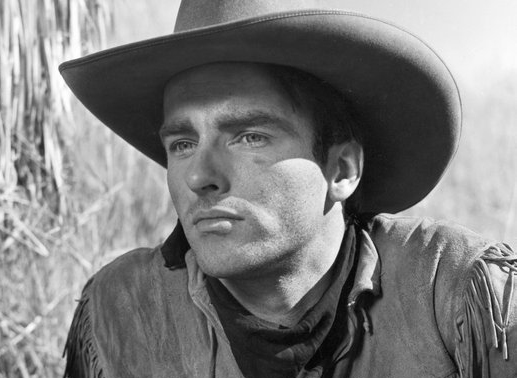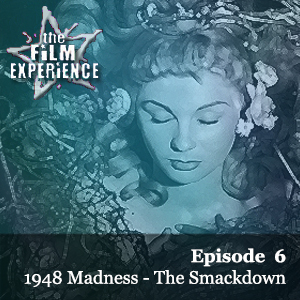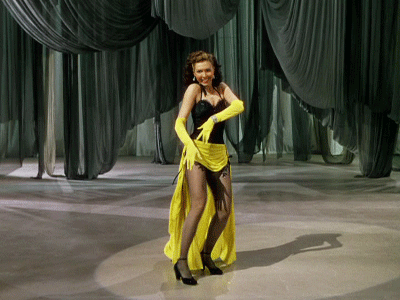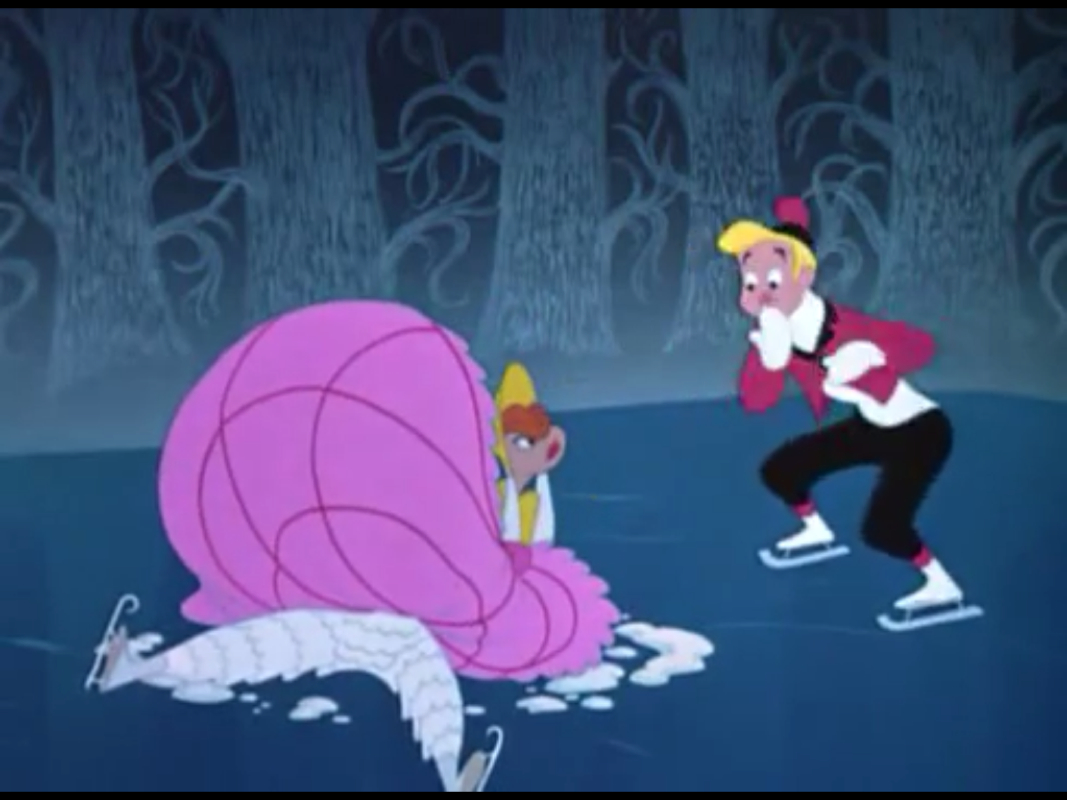Presenting the Supporting Actresses of '48. A young writer, a drunken chanteuse, two spinster aunties, and a girl who never gets to the nunnery.
THE NOMINEES
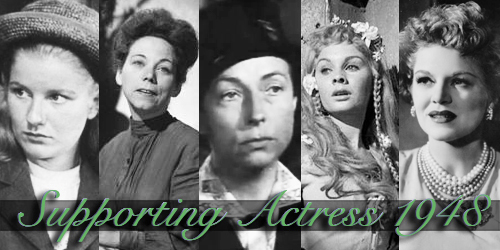
1948 is so basic. A typical Best Supporting Actress shortlist looks almost exactly like this: an actress whose paid her dues finally getting a plum opportunity (hello usually uncredited Ellen Corby in I Remember Mama finally stepping into the limelight), a rapidly rising star (Jean Simmons in Hamlet, not her first attention grabbing role in the late 40s), a fresh ingenue in a popular picture (Meet Barbara Bel Geddes in I Remember Mama), and if you're lucky in a good year a couple of revered character actresses to class up the shortlist joint (Agnes Moorehead in Johnny Belinda and Claire Trevor in Key Largo). And within that mix you'll usually have a protagonist demoted to "supporting" and Best Picture heat helping at least a few of them find a seat at the table. All of that is true for 1948. What isn't so typical is a supporting actress winning on a picture's sole nomination and that happened here. Key Largo has aged well but Oscar didn't have any time for it back then outside of Trevor's drunk despair. The other three pictures had 24 nominations between them!
THIS MONTH'S PANELISTS
Here to talk about these five turns are screenwriter/author Abdi Nazemian ("The Walk in Closet"), film blogger Catherine Stebbins (Cinema Enthusiast), freelance journalist Joe Reid, film critic Tim Robey (The Telegraph), and your host Nathaniel R (The Film Experience). In addition to this write up we recorded a companion podcast where we flesh out some of these thoughts and expound on the movies themselves.
Without further ado...
1948
SUPPORTING ACTRESS SMACKDOWN
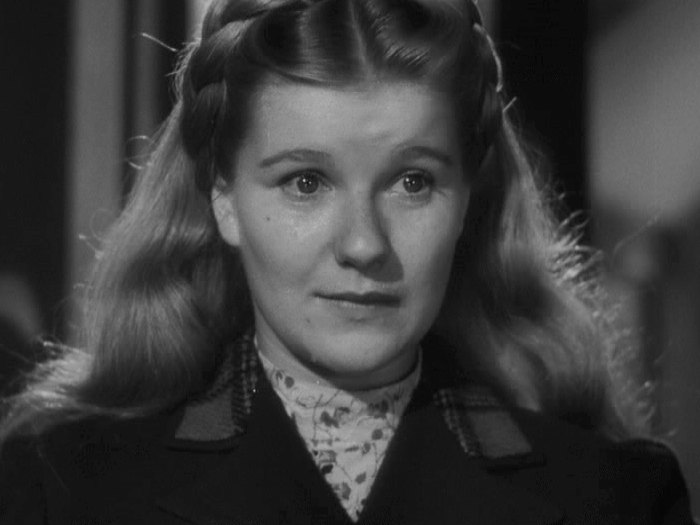
BARBARA BEL GEDDES as "Katrin" in I Remember Mama
Synopsis: A teenager who dreams of being a writer finds source material in her immigrant mother
Stats: Then 26 yrs old, 2nd film, first and only nomination. 72 minutes of screen time (or 54% of running time).
Abdi Nazemian: She carries much of the emotional life of the film, but I found the film unbearably sentimental (this from a man who loves Andy Hardy movies and Little Women). She lacks the unique quirks that young actors like Judy Garland and Mickey Rooney brought to the same kinds of roles, and gives us a bland portrayal of adolescence. Of all the nominated actresses, she was given the most screen time, and did the least with it. ♥
Catherine Stebbins: One of these days I’ll figure out why I’m always so drawn to Bel Geddes. She has a lot of screen time as Katrin, given the unenviable task of holding up the film’s relentless episodic nostalgia. She is narrator, observer, worshiper, and an adult playing an adolescent. Katrin constantly looks at her mother, whether in the background or foreground, with reverent awe. Bel Geddes plays this with a partial cognizance that Katrin is in the gently reenacted memories of her past. ♥♥♥
Joe Reid: I can see how, if you were swept up in the homey charms of George Stevens' film, you'd want to throw accolades at Bel Geddes, who plays such an observant window onto the life of her saintly mother. Her hushed voice-over gets to the gauzy-memoir nature of the story effectively, but I'm not sure the performance ever gets much farther than doe-eyed wonderment. ♥♥
Tim Robey: Saddled with just about the hoariest framing narration in film history, and doing little to lift it out of sanctified goo, Barbara has a near-impossible task here – making the terminally precious Katrin and her “gifted” (read: soporific) memoirs interesting. She can’t win, but we still need something more than a voice like tree sap to get us through this. In overegged close-ups she’s weirdly divorced from real-time engagement with her scenes, and every co-star seems faintly embarrassed about what to do with her. ♥
Nathaniel R: In the movie's crowded frames, you can often see just her hair or the back of her head; unfortunately her full closeups aren't that much more expressive, generally landing a single emotion. The narration is even stiffer like she's reading to a very small child from an immobile body cast. (The direction and screenplay all but force this stiff repetitiveness though, so it's not all on her) She aces warm awestruck looks at goddess Irene Dunne, but... I mean... who doesn't? ♥
Reader Write-Ins: "She is telling THEIR story, which she happens to be in. Therefore she is bland, quiet, blending to the background so others can showcase themselves." - Tom (Reader average: ♥♥¼)
Actress earns 10¼ ❤s
four more actresses after the jump

Click to read more ...
 Tuesday, June 30, 2015 at 1:26PM
Tuesday, June 30, 2015 at 1:26PM 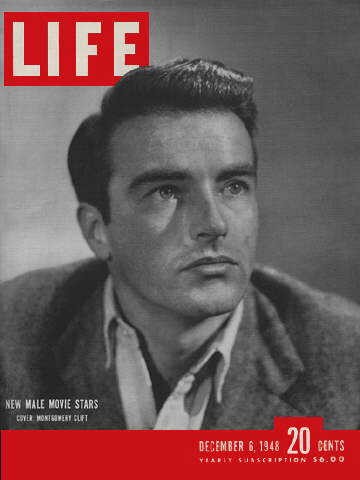 Before there was Brando and James Dean there was Montgomery Clift. And while those actors are often credited for bringing a new type of leading man to the big screen, through a mix of masculine machismo with feminine vulnerability, without Clift paving the way, the future of acting might have looked far different. The country was just emerging from the hardships of WWII. After seeing the travesties of war firsthand, they were ready for something more realistic and Clift was the answer to the change they were seeking. Having worked as a stage actor for over 10 years (where he made his Broadway debut at age 15 in the Pulitzer Prize-winning There Shall Be No Night), Clift was a serious actor that had honed his craft and emerged fully-formed in Hollywood with his first two films, both released in 1948, the western Red River and the post-war drama The Search.
Before there was Brando and James Dean there was Montgomery Clift. And while those actors are often credited for bringing a new type of leading man to the big screen, through a mix of masculine machismo with feminine vulnerability, without Clift paving the way, the future of acting might have looked far different. The country was just emerging from the hardships of WWII. After seeing the travesties of war firsthand, they were ready for something more realistic and Clift was the answer to the change they were seeking. Having worked as a stage actor for over 10 years (where he made his Broadway debut at age 15 in the Pulitzer Prize-winning There Shall Be No Night), Clift was a serious actor that had honed his craft and emerged fully-formed in Hollywood with his first two films, both released in 1948, the western Red River and the post-war drama The Search. 